Every year, more than 3,000 people die in the UK from accidental carbon monoxide (CO) fumes. To prevent the deadly risk due to this toxic gas produced by boilers and water heaters, you must install a carbon monoxide detector. To help you choose, we propose through this guide the best carbon monoxide detectors of the moment.
Here is our commitment, to make sure that we provide the best user experience and content quality:
You can support us by using our links to make your purchases (at no extra cost to you)! This sometimes earns us a commission which allows us to remain independent. More about us
Our selection
"The reliability of the Siemens brand is reflected in the Delta Reflex 5TC1260 carbon monoxide detector. Discreet and easy to install, it offers a lifetime…"
"Despite the low price, this easy-to-install carbon monoxide detector comes with a 10-year life span, an ultra-sensitive electrochemical sensor and an 85 dB alarm."
"Google's second-generation Nest Protect is still smart, still more sensitive and more self-contained with its 10-year lifespan. Plus, you can turn off the alarm remotely."
"The X-Sense SC07 has nothing to be ashamed of compared to the models presented above. This EN 14604 and EN 50291 certified 3-in-1 device is…"
"This carbon monoxide detector has all the right points: effective, discreet, easy to install, inexpensive. It has a life span of 10 years and warns…"

The reliability of the Siemens brand is reflected in the Delta Reflex 5TC1260 carbon monoxide detector. Discreet and easy to install, it offers a lifetime and a 10-year warranty.
35,12 £ on AmazonA 10-year warranty and life span accompanied by NF EN 50291 certification demonstrate the reliability of the Siemens Delta Reflex 5TC1260. With a sealed battery, which activates automatically as soon as the device is attached to its base, the product's design prevents accidental tinkering. But you can turn it off and delay its restart if you are away for a long time. We particularly like its advanced electrochemical sensor, which continuously measures the level of CO, Its very discreet style and its practicality.
This carbon monoxide detector can be easily fixed to the wall, the ceiling or placed on a piece of furniture. In addition, regular self-diagnosis ensures that the device is working optimally. And a beep will be heard for 30 days when the battery needs to be replaced. What is certain is that you will not find a CO detector with a 10-year warranty cheaper than the Siemens Delta Reflex 5TC1260.
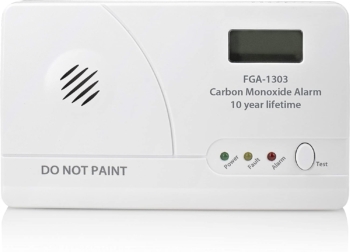
Despite the low price, this easy-to-install carbon monoxide detector comes with a 10-year life span, an ultra-sensitive electrochemical sensor and an 85 dB alarm.
17,21 £ on amazonFor its carbon monoxide detector, Smartwares has combined a remarkable sensitivity and a very competitive price. Indeed, to find a lifespan of 10 years and a detection threshold of 30 ppm is a real challenge at the price proposed by the manufacturer. The device has a hyper sensitive electrochemical sensor that activates an 85 dB alarm as well as an LED indicator if it detects an abnormal concentration of carbon monoxide. It also warns in case of failure, need to change the batteries or end of life of the sensor.
You can also view the measurements on the LCD screen, quite rare on a CO detector at this price. This model also comes with all the necessary installation kit and is very easy to install. It is also possible to test its operation thanks to a button specially designed for this purpose and the manufacturer recommends to carry out this step once a month.
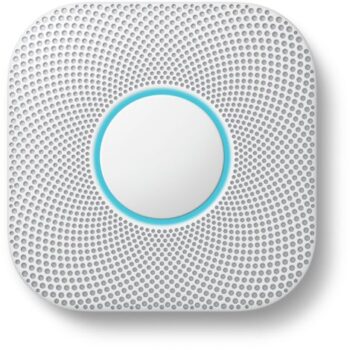
Google's second-generation Nest Protect is still smart, still more sensitive and more self-contained with its 10-year lifespan. Plus, you can turn off the alarm remotely.
95,20 £ on AmazonGoogle has completely redesigned its Nest Protect. Now, the autonomous alarm has a dual-spectrum sensor, is self-testing and has a 10-year life span. In addition, it can distinguish between slow or fast combustion, steam or smoke. Thanks to the Nest application, it is also the first DAAF and DACO detector whose alarm can be deactivated from a smartphone. As with the first generation, the night light function is still present. It has even been improved.
All family members can control the device and be alerted by smartphone message in case of danger. A test/pause button allows you to check if the detection is working but also to deactivate the alarm. And you can view the report of each test on your smartphone. Nest Protect makes your life easier by checking its batteries and sensors over 400 times/day. And if it's low on charge, the app sends you a message before beeping.
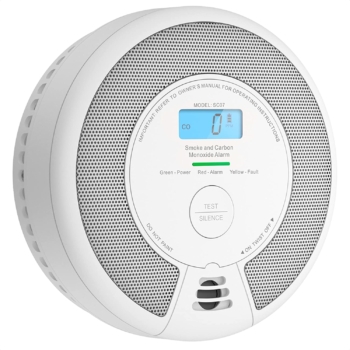
The X-Sense SC07 has nothing to be ashamed of compared to the models presented above. This EN 14604 and EN 50291 certified 3-in-1 device is a carbon monoxide detector, smoke detector and fire alarm all in one.
33,02 £ on AmazonThe X-Sense SC07 has features that are well worth the trip. Its versatility allows it to Combine carbon monoxide detection, smoke detection and fire alarm. Equipped with independently operating photoelectric and photochemical sensors, this is a device with exceptional sensitivity and accuracy. It even detects anomalies at 360° without blind spot by taking 3 samples of the surrounding air.
Real-time CO levels, updated every 10 seconds, and battery status are displayed on a large LCD screen. If the CO level ever reaches the critical threshold, a powerful 85 dB alarm is triggered and the red LED lights up. As for quality and reliability, this CO detector is certified to EN 14604 and EN 50291 and its battery can last 10 years. It is also equipped with a self-diagnosis system and a yellow LED indicator warns you in case of anomaly. Finally, you can disable a false alarm by pressing the Silence button.
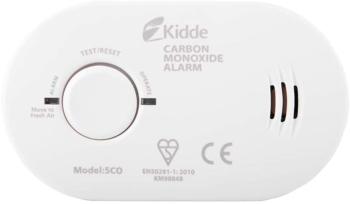
This carbon monoxide detector has all the right points: effective, discreet, easy to install, inexpensive. It has a life span of 10 years and warns by alarm and LED light in case of critical CO threshold.
17,58 £ on AmazonKidde has set the bar very high with its 5CO model which has all the assets to seduce. It offers 10 year life span and comes with CE and Kittemark certificationIt is a feat considering the price. It is also a light device (115 g), with neat finishes, very easy to use, that you can hang on the wall, put on a table or even take with you.
The Kidde 5 CO continuously monitors the carbon monoxide level in the air and warns with a loud alarm and a red LED indicator as soon as the danger threshold is crossed. And to reassure you of its reliability, simply perform a regular diagnostic by pressing the test button. An alarm also sounds when the device reaches the end of its life.
Any specific needs?
The best carbon monoxide detector in 2021
The best entry-level carbon monoxide detector
The best high-end carbon monoxide detector
A versatile carbon monoxide detector
Your guide :
Rate this buying guide :By rating this buying guide, you are helping us to reward our best writers. Thank you!
| THE BEST | LESS EXPENSIVE | HIGHEST RANGE | Polyvalent | Alternative | |

In accordance with our commitment, this buying guide does not contain any sponsored products. |
 9/10 |
 8/10 |
 9/10 |
 9/10 |
 7/10 |
| OUR SELECTION |
Siemens Delta Reflex 5TC1260
|
Smartwares FGA-1303
|
Nest Protect DAAF-DACO 2nd generation
|
X-Sense SC07
|
Kidde 5 CO
|
|
The reliability of the Siemens brand is reflected in the Delta Reflex 5TC1260 carbon monoxide detector. Discreet and easy to install, it offers a lifetime and a 10-year warranty.
|
Despite the low price, this easy-to-install carbon monoxide detector comes with a 10-year life span, an ultra-sensitive electrochemical sensor and an 85 dB alarm.
|
Google's second-generation Nest Protect is still smart, still more sensitive and more self-contained with its 10-year lifespan. Plus, you can turn off the alarm remotely.
|
The X-Sense SC07 has nothing to be ashamed of compared to the models presented above. This EN 14604 and EN 50291 certified 3-in-1 device is a carbon monoxide detector, smoke detector and fire alarm all in one.
|
This carbon monoxide detector has all the right points: effective, discreet, easy to install, inexpensive. It has a life span of 10 years and warns by alarm and LED light in case of critical CO threshold.
|
|
|
Lifetime
|
10 years
|
10 years
|
10 years
|
10 years
|
10 years
|
|
Detection quality
|
|
|
|
|
|
|
Warning type
|
85 dB alarm
|
85 dB alarm and LED light
|
Smartphone messaging and audible alarm
|
85 dB alarm and LED light
|
85 dB alarm and LED light
|
|
Standard
|
NF EN 50291
|
|
EN14604
|
EN 14604 and EN 50291
|
CE and Kittemark
|
|
LCD display
|
|
|
|
|
|
|
Connection
|
|
|
|
|
[V
|
|
Malfunction signal
|
|
|
|
|
|
Help us improve this table:
Report an error, request the addition of a feature to the table, or suggest another product. Thank you for your kindness!
We spend thousands of hours each year studying the major specialized websites, analyzing products of hundreds of brands and reading user feedback to advise you on the best products.
We are a product review company with a single mission: to simplify your buying decisions. Our research and testing helps millions of people every year find the best products for their personal needs and budget.
To support us you can: use our links to make your purchases (which often earns us a small commission), share our articles on social networks, or recommend our site on your blog. Thanks in advance for your support!
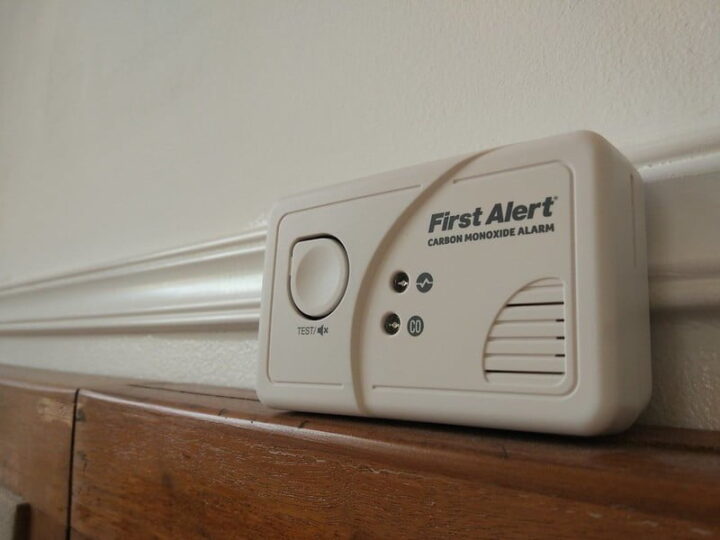
Certification is the first criterion to consider before choosing a carbon monoxide detector. The latter must meet the European standard and the NF DAACO quality mark. This gives information on the sensitivity and efficiency of the device. The NF DAACO quality mark is a guarantee of quality and safety. The products with this certification have undergone rigorous controls at different stages: manufacturing control, audits and monitoring tests...
As opposed to the smoke detector which is triggered as soon as the concentration of particles from combustion is detected, the carbon monoxide detector triggers a visual and sound alert. The delay before warning depends on the duration of exposure and the level of carbon monoxide concentration. For a CO concentration of 300 ppm, the alert is triggered in less than 3 minutes. For 100 ppm CO, the alert is triggered after 10 to 40 minutes. If the concentration is 50 ppm, the alarm will sound after 60 to 90 min. And for low concentrations, 30 ppm, it will take 120 min.
Prefer battery power. These are not batteries that need to be replaced every month or year, but have a life span of 7 or 10 years. Note that there are two types of self-contained CO detectors on the market, those with replaceable batteries and those with long-life batteries. The long-life batteries are usually sealed inside the detector and do not require any handling or replacement. You simply install the unit and let it do its job. Most battery-operated CO detectors will give an audible and visual signal when the batteries or the unit need to be replaced. Make sure these are present before you choose.
Carbon monoxide is invisible, odorless and non-irritating. Its emanations cause thousands of hospitalizations and a hundred deaths per year in the UK. The main sources are boilers and water heaters running on gas or oil. If you use these appliances, install a carbon monoxide detector nearby.
Some carbon monoxide detectors have a display. It allows you to know the level of carbon monoxide present in the room. Thus, you will be warned if the rate becomes abnormal or starts to rise little by little. This will allow you to quickly take the necessary measures. The models equipped with a test and pause button are also interesting, as they allow you to regularly check the state of the appliance. You can then check that the batteries, the circuit and the alarm are working properly. Indeed, sometimes the self-diagnosis does not work.
Do you really need one?
Since 2016, the smoke detector is mandatory in all houses on the French territory. For the carbon detector, it depends mainly on the equipment you use. Indeed, not all homes are exposed to the same risks. Each person must decide whether or not they need one.
To do this, determine whether your home has combustion heating systems such as wood, oil and coal stoves. Open fireplaces are also a hazard. Mobile oil-fired space heaters and gas or oil-fired water heaters are also a hazard.
Location
Install a carbon monoxide detector in every room with a combustion appliance such as a water heater and gas or oil furnace. These include the kitchen, living room, bedrooms or bathroom. For remote boilers, it is better to place the detector outside the boiler room but still in the house so that the alarm remains audible.
Ideally, place the carbon monoxide detector between 1 and 3 m horizontally from the source. For bedrooms, the detector should be close to the headboard.
Installation
Carbon monoxide detectors are often sold with mounting screws. Thus, you can install them on the ceiling at 30 cm from the wall, or on the wall between 10 and 15 cm from the ceiling. Remember to mount the detector more than 1 m away from any appliance that may emit carbon monoxide or water vapor. Also, avoid proximity to any air vents or ventilation systems.
For detectors with LCD screens, avoid mounting them on the ceiling, unless the height is relatively low. And place them at ground level so that you can read the indications.
The principle of operation of a carbon monoxide detector is similar to that of an automatic smoke detector (ASD). A battery-powered sensor triggers a sound and light signal to alert occupants as soon as the level of CO in the indoor air reaches a potentially dangerous threshold according to current standards.
Wired or wireless?
Some smoke and carbon monoxide detectors can be interconnected. This allows units in the house to sound the same alarm when one of them goes off. In some newer homes, there is already wiring to connect the detectors. If not, you buy detectors that can interconnect wirelessly.
Single or multi-level home?
Interconnected smoke and carbon monoxide detectors are especially useful if you live in a multi-level home. For single-level homes, stand-alone detectors are more than sufficient.
What are the limitations?
While interconnected alarms can make your home safer, they do have some limitations. In many cases, only detectors of the same brand can connect to each other. So check with manufacturers or vendors for compatible models, even within the same brand.
Despite the limitations, interconnected detectors are best. They will warn you before the fire or carbon monoxide spreads. Wired or wireless, interconnected detectors increase home security. Of course, this comes at a cost.
The best way is to buy your carbon monoxide detector online. It will be less expensive than in a store. In addition, delivery is at the seller's expense. In addition, all models sold on the internet comply with the NF EN 50291 standard and the European directives on CO gas emissions.
Another advantage of buying online is that you can return the detector within 14 days if you are not satisfied. This means that you have 2 weeks to test it. For the purchase, the websites of the DIY stores are indicated. We particularly recommend the Manomano site, but also those of Leroy Merlin and Castorama. Amazon can be a good alternative.
They detect carbon monoxide fumes in the home, but are insensitive to smoke and explosive gases. Their simplicity is both a quality and a flaw. Some models are equipped with a screen showing in real time the level of CO they detect. Others are able to read the CO level via audio messages.
Benefits:
Disadvantages :
Who is it for?
If you already have smoke and explosive gas detectors and use an oil or gas furnace, this type of carbon monoxide detector will be essential for you.
These
are 2-in-1 devices, both smoke detectors and carbon monoxide detectors. They integrate ionization or photoelectric technologies as well as an electrochemical sensor for CO. However, these types of autonomous alarms are not controlled from a smartphone and smoke detection is sometimes favored over carbon monoxide.
Advantages:
Disadvantages:
Who is it for?
If you need a carbon monoxide detector and you don't have a smoke detector yet, this kind of device can be very interesting. Some models are incredibly effective.
Connected standalone alarms notify family members via smartphone in case of fire or toxic fumes. These notifications will happen no matter where you are. On the other hand, there is no smart standalone smoke and CO alarm to date that does everything successfully. So, if you install this type of equipment, add dual sensor smoke detectors.
Advantages:
Disadvantages:
Who is it for?
The smartphone apps of these autonomous alarms and their connectivity allow them to warn all family members, a real plus for safety. All users can change the settings. Without consultation between family members, this will cause more problems than benefits.
Check the detector's packaging to ensure that it complies with Underwriters Laboratories standards (UL label) and French and European standards. You should also look for the date of manufacture printed on the back. These devices lose sensitivity over time. As a rule, replace your carbon monoxide detectors every 5 years.
It is the best device to alert on the presence of carbon monoxide in a room. Autonomous, its possession avoids the risk of intoxication with this type of deadly and odourless gas. Its principle of operation is based on the reaction of a chemical solution which composes it, this one reacts in contact with the carbon monoxide. Having a carbon monoxide detector will give you a chance to survive.
Note that it works regardless of temperature or humidity fluctuations, or the presence of other gases in the air. However, the alarm may not work when it encounters certain rare gas mixtures.
This device detects smoke and alerts the occupants of the house or building. The alarm reacts in the presence of steam or smoke in the air. Very easy to install, the smoke detector may not require wiring or flush-mounting work. Some models can work in conjunction with other detectors and operate as a network, perfect for large apartment buildings.
However, if you choose a model that runs on batteries, it can run down at any time. This means that you need to check the operation of these devices, including wireless models.
In terms of safety, the smoke detector is more interesting than the carbon monoxide detector. The latter, however, can save lives. And recently, there are devices that are both smoke detectors and carbon monoxide detectors.

Your safety and that of your family
in the UK, the figures speak for themselves. More than 3,000 people are victims of carbon monoxide poisoning every year, and about a hundred of them die. Dangerous, this gas remains odorless, colorless and invisible. So to avoid serious intoxication, or even death, it is essential to equip yourself with a CO detector. In particular if you use a water heater or a boiler at risk.
This gas generally comes from the combustion of fossil fuels such as gasoline, fuel oil, wood and coal. If you use gas or oil-fired water heaters, as well as gas stoves, wood or pellet fireplaces, wood stoves, flue gas boilers or charcoal barbecues, the risk is very high. Only a carbon monoxide detector can warn you of abnormal levels.
Avoiding carbon monoxide poisoning
Carbon monoxide often causes headaches, asphyxiation and loss of consciousness. Carbon monoxide poisoning can be fatal in high concentrations or if inhaled for a long time. Symptoms are flu-like, including mild headaches, fatigue, nausea and vomiting. This can quickly progress to severe headaches and drowsiness, which can lead to death.
The only way to prevent this from happening is to install a carbon monoxide detector, not just a smoke detector that warns of a fire. This device allows you to quickly detect the presence of this toxic gas in the air even before the first symptoms appear.
Avoiding a robbery attempt
Not only does this device save your life, but it can also prevent attempted theft. Indeed, some burglars use this gas to put the occupants to sleep. The audible signal sent by the detector quickly warns of the high presence of CO and can thus dissuade thieves and make them flee. In short, it is necessary to be prepared for any eventuality, because an informed man is worth two!
Carbon monoxide detectors should not be confused with carbon monoxide testers. The first is a device to be installed or fixed to the wall and ceiling capable of triggering an alarm. The second is a simple device without alarm.
In our opinion, the best brands of carbon monoxide detectors in 2022 are :
The German brand has had its name associated with excellence for over 160 years. Innovation, precision and reliability are its core values. It is no surprise then that Siemens often sets new standards in engineering, especially in the field of power transmission and distribution. One of its core areas of expertise is in the field of indoor climate control, hence the excellent Siemens Delta carbon monoxide detectors.
If you have a smoke detector or carbon monoxide detector, you may have already recommended this brand. AngelEye products combine state-of-the-art technology, design and reliability. These detectors will satisfy the most demanding customers.
This brand offers mainly entry-level smoke and carbon monoxide detectors. It places great emphasis on design and innovation, not to mention reliability. Its detectors rank among the very best for home security.
Google created Nest and the Nest Protect line, which makes security cameras, thermostats and various types of detectors. The American giant has reshuffled the cards in the carbon monoxide detector market with the famous Nest Protect. For the second generation, the functionalities of the Nest autonomous alarm go further.
Smartxare is an expert brand in security, safety and functional lighting. Its aim is to make the home safer and more comfortable. Its fields of application are lighting, smoke detectors, carbon monoxide detectors or intrusion alarms. The products are affordable and designed for the general public.
The diagram below will help you to get an idea of the typical prices for each price range (entry-level, mid-range and high-end).
However, more expensive does not necessarily mean better.
We therefore advise you to always consult our ranking before deciding, rather than blindly relying on price ranges.
Set up at eye level.
If you have a carbon monoxide detector with a digital display, install it at eye level so it's easy to read.
Install on each floor.
Install a carbon monoxide detector on each floor of your home. This way, you'll maximize response time in case of a problem. The whole family will be alerted at the same time.
Make sure the alarm wakes you up.
Place your carbon monoxide detector where it will wake you up if the alarm goes off at night.
Replace the batteries every year.
Many manufacturers recommend replacing the batteries in carbon monoxide detectors at least once a year. If you hear your detector beep or chirp, replace the batteries immediately.
Test every month.
Don't rely on self-diagnostics. Test your carbon monoxide detectors at least once a month to make sure they're working properly.
Place your carbon monoxide detector where it will wake you up if the alarm goes off in the middle of the night. And if your carbon monoxide detector sounds an alarm, make sure everyone, including pets, evacuates immediately.
Have your water heater or heating system checked regularly by a qualified technician to make sure it is working properly. This can help reduce your risk of carbon monoxide poisoning.
According to our research, most users consider the Siemens Delta Reflex 5TC1260 to be the best carbon monoxide detector on the market. And the qualities of this model prove them right.
Carbon monoxide is an odourless gas, invisible to the naked eye and non-irritating. This makes it particularly dangerous. All homes with gas or oil fired boilers and water heaters are subject to carbon monoxide fumes. And if you happen to use a generator inside the house, this problem also concerns you.
Consider certifications, sensitivity and battery life. You will also need to choose based on the size of your home, the number of potentially dangerous equipment and the features.
If you already have smoke detectors, stand-alone alarms won't really help. For bedrooms or bathrooms, opt for a carbon monoxide detector with a digital display.
There are simple CO detectors, conventional stand-alone alarms and connected stand-alone alarms. The latter have smartphone apps and can send alert messages, diagnostic reports or light up the room when you are present.
The best carbon monoxide detectors have a life span of 7 or 10 years. Some models require a new battery every year. On average, change your detector every 5 years, regardless of whether it still works. This is because these devices become less sensitive over time.
Every month we help more than 1 000 000 people buy better and smarter.
Copyright © 2022 - Made with ♥ by buyingbetter.co.uk
Your reviews and buying guides 0% advertising, 100% independent!